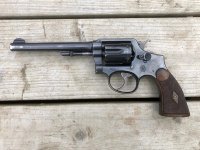tripledipper
Member
I have acquired a revolver which is a 32-20 caliber. The serial # is 74051, the last Patent number on the 4-1/4" barrel says 01DEC17 and 32 WCF CTG, the serial number is on the cylinder and butt. The grips are wood with a gold S&W emblem. Without a picture, this is a shooter grade, the cylinder, frame and barrel have lost much bluing, barrel rifling looks good and cylinder locks up fairly tight. Is this an I-frame or a K-frame? Approximate value? I thought this was a 32long, not a 32-20, did not do my homework and don't wish to keep it. Should I put it for sale/trade on the forum with pictures? Would be glad to trade for a 32long of equivalent value or sell it outright.

